Hubspot Email Marketing review 2026: Is it the best value for your business?
 MailerLite team members, Harmony and Arnold
MailerLite team members, Harmony and Arnold
Considering HubSpot for email marketing, but feeling overwhelmed by the options and the cost? You're not alone.
Given HubSpot’s powerful capabilities (that come with an equally mighty price tag!), there might be questions that come to mind.
Do I pick an all-in-one platform or a specialized email marketing tool?
Which features do I truly need, which are good-to-have, and which haven’t I considered yet?
How do I get the most out of HubSpot without breaking the bank?
Our HubSpot Email Marketing review cuts through the noise. I've taken a hands-on approach, exploring HubSpot's email marketing capabilities to help you decide if it's the right fit for your business.
This article covers getting started—from importing contacts to launching your first campaign—followed by a deep dive into HubSpot's email marketing tools, from the editor to the automation workflows. I’ll show you the firsthand results of my ‘experiments’.
Finally, you’ll find a cost-benefit analysis of what you get for the money you pay, and what could be the most efficient investment for your business.
Let’s begin!
Quick overview: What is HubSpot Email Marketing?
HubSpot Email Marketing is a part of its Marketing Hub, which is a separate product from its customer relationship management (CRM) platform.
With HubSpot Email Marketing, you can design and send professional emails using a simple drag-and-drop editor. It helps you automate emails, personalize your content, and segment your audience effectively.
You can also track your campaign’s performance and integrate with other marketing and sales efforts from within a single platform. This, in my opinion, is HubSpot’s unique selling point (USP). Simply put, HubSpot helps you manage customer relationships through highly data-driven email campaigns.
Who is HubSpot best suited for?
HubSpot Email Marketing suits mid to larger enterprise-level companies with big budgets that need an all-in-one platform. It's best-suited for companies with complex sales cycles or those who value a unified view of every customer interaction across marketing, sales, and service.
If you have a larger budget and need advanced marketing automation or detailed reporting, HubSpot offers that comprehensive solution.
How did I collect data for this review?
To truly understand HubSpot, I went beyond just research and reviews. I personally tested the platform, using a step-by-step approach. I checked everything: from setting up initial emails to the often-tricky process of domain authentication, sending test campaigns, trying out email automation, and analyzing performance.
Crucially, I also spent time dissecting HubSpot's pricing structure and its email marketing value. This cost-benefit analysis helped me see how the platform truly serves (or doesn't) the specific needs of small to mid-sized businesses, agencies, consultants, coaches, and creators.
Getting started with email marketing in HubSpot
Ready to explore email marketing with HubSpot? Here's a hands-on look at what you'll encounter as you begin, from importing contacts to building your first campaign.
1. Importing and segmenting contacts
My initial experience with importing contacts was quite straightforward. If your data is clean, HubSpot makes it easy with clear prompts for CSV files.

Hubspot’s tools are robust for creating both static and active (dynamic) lists based on almost any contact property—from standard fields like first name, last name, job title, contact details, and email ID to critical HubSpot-specific data points like lifecycle stage (subscriber, lead, marketing qualified lead, customer, opportunity, and evangelist).
You can further segment based on engagement status, like 'open,' 'in progress,' or 'unqualified.' This granular control is a huge advantage for targeting.
However, unlocking the full potential of this granular segmentation for truly advanced, automated workflows often requires higher-tier plans, limiting its utility for users on free or Starter plans.
2. Connecting your email sending domain
Connecting your domain is vital for email deliverability and sending professional-looking emails. HubSpot offers clear instructions on adding the necessary DNS records. However, I immediately hit a wall.
A message appeared stating I can’t authenticate my email sending domain (with DKIM, SPF, and DMARC) on HubSpot's Free Marketing Hub.
Without this, my test email landed in the inbox looking less professional, sent from a HubSpot-managed domain. This can affect whether your emails even reach the inbox. Full authentication, crucial for email deliverability, is a paid feature on HubSpot.

3. Creating a branded email template
This is typically very easy and enjoyable thanks to HubSpot's drag-and-drop editor. It asks whether you want to craft a regular, automated, or blog/RSS update email. I chose the regular option.
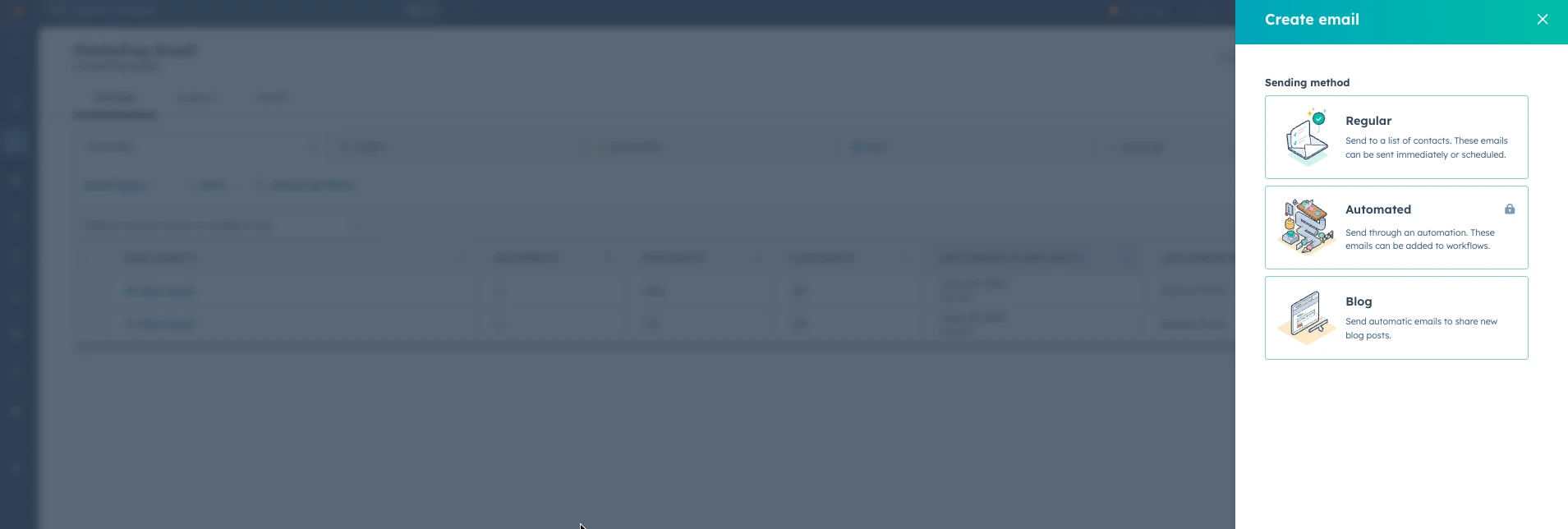
I found a good variety of pre-designed templates available. Having said that, compared to other platforms, the variety might feel somewhat limited, especially for those seeking highly specific designs without extensive customization.
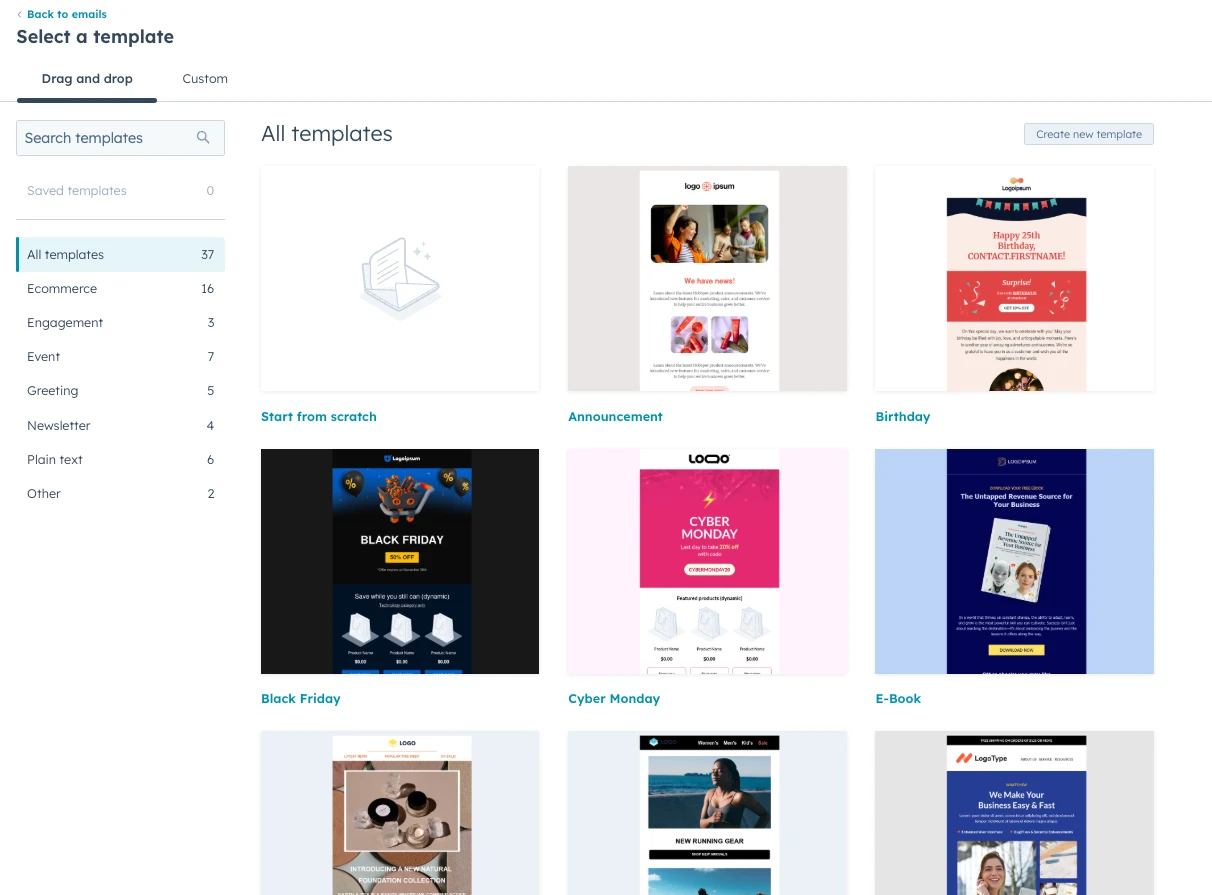
It was easy to customize these with my brand colors, fonts, and logos, and I appreciated how mobile-responsive the emails are by default.
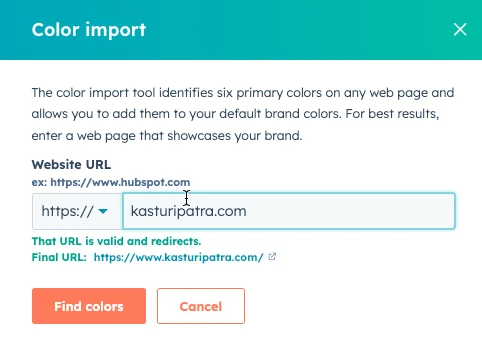
The preview option lets you check how your email looks on desktop and mobile. You can also view your email as a specific contact for a personalized check.
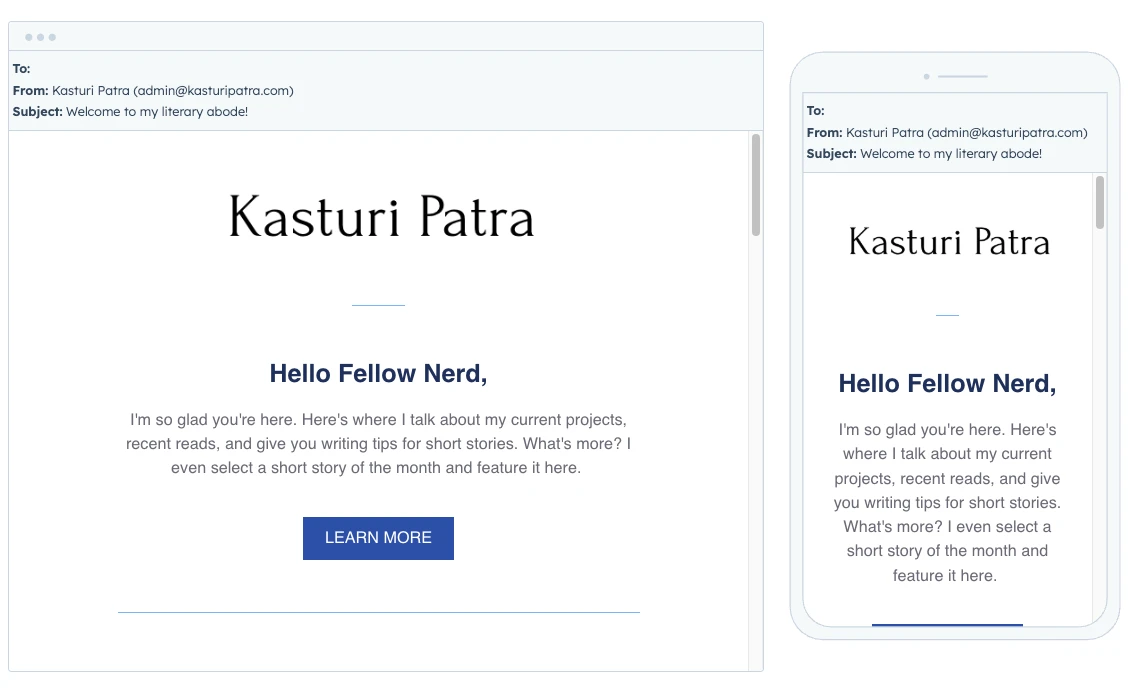
4. Building your first email campaign
Building an email campaign here felt straightforward, thanks to the drag-and-drop editor. Once I picked a template, placing content blocks was simple.
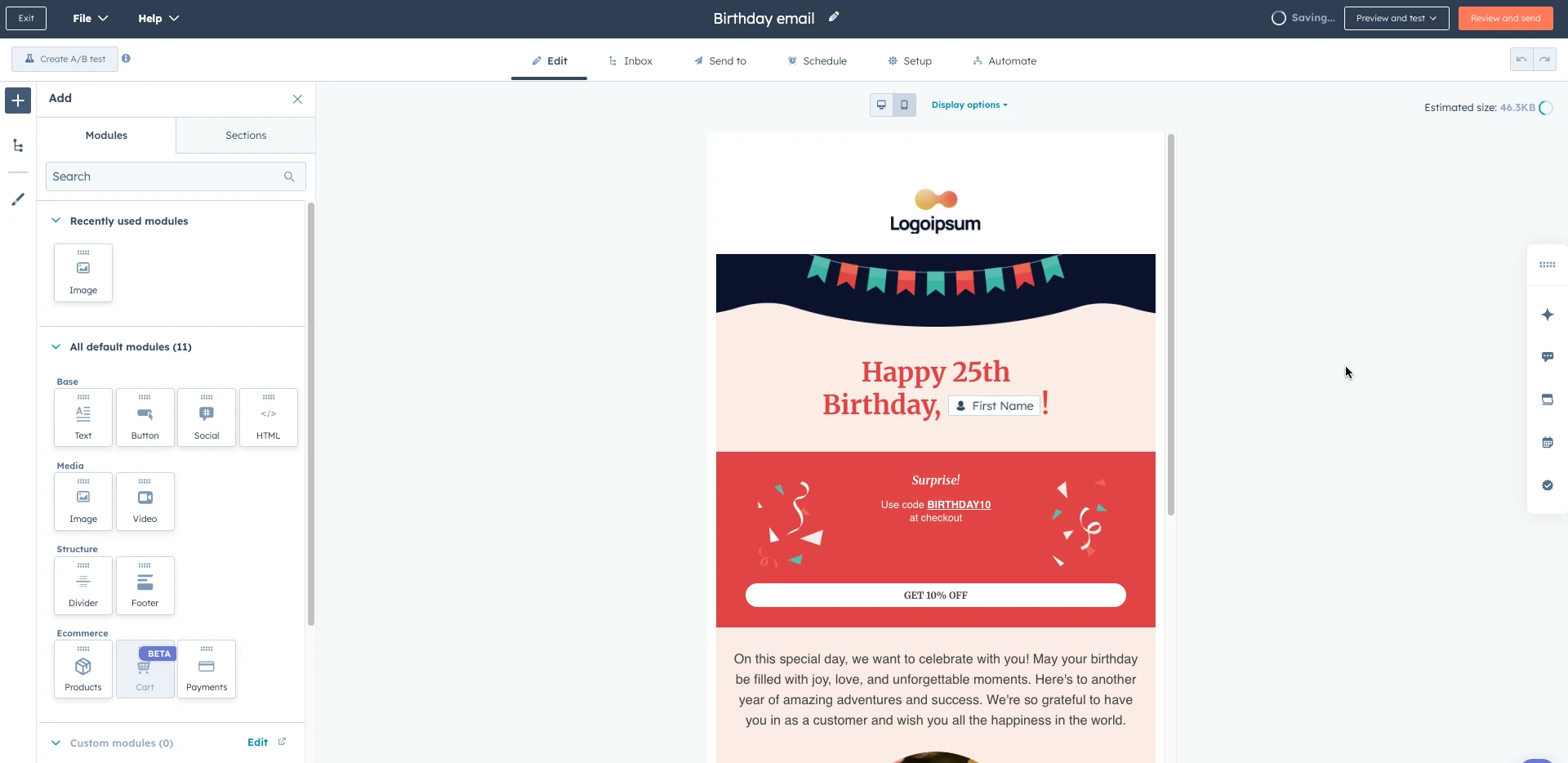
What I liked was the organized layout: separate tabs let you schedule your email, pick your sender list, and personalize content. You can even make content dynamic or set up marketing automation—all from the same email view. There's also an option to use AI for text suggestions, which is a nice touch.
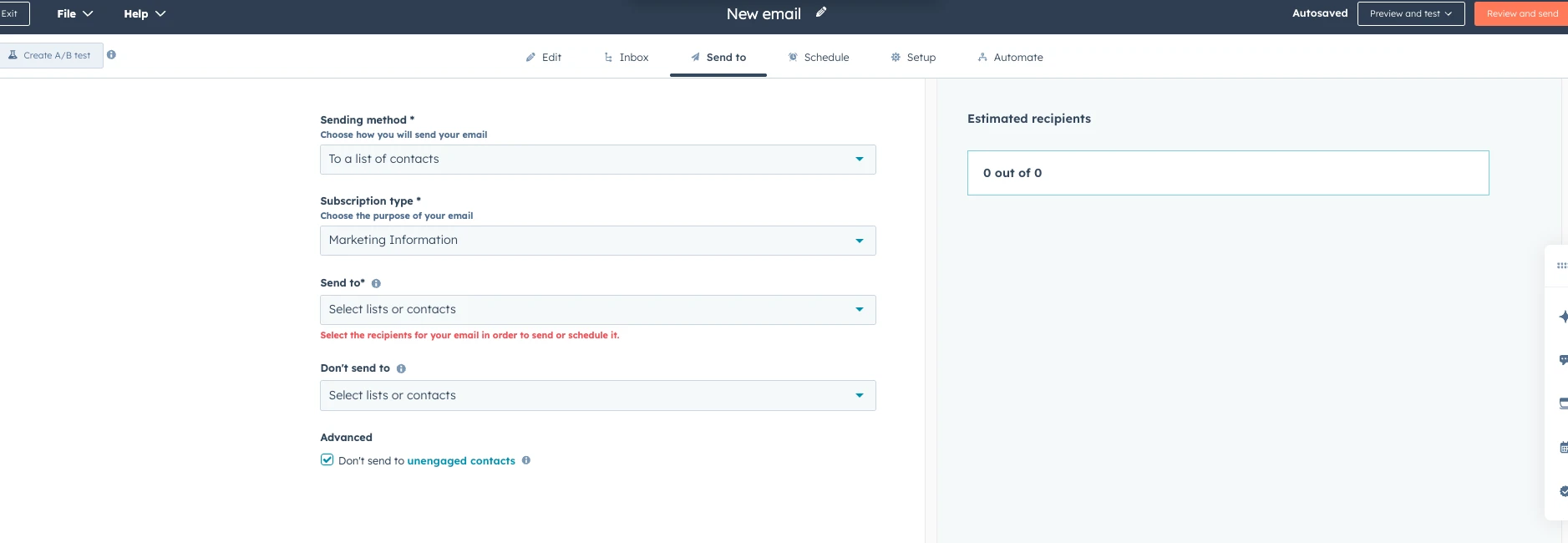
This structured approach, in my experience, really helps keep campaigns organized. However, many of these advanced functionalities—like dynamic content or comprehensive automation—are reserved for HubSpot’s Professional tier. That plan starts at a significant $890 per month (billed annually). This means while the tools are there, their full power comes at a considerable cost.
HubSpot Email Marketing features
Let's check out some of the important features on the HubSpot Email Marketing platform:
Drag-and-drop email editor
HubSpot's email editor is, in my opinion, a strong point for its usability. You just drag and drop blocks, and you can quickly build professional-looking emails. The interface itself feels clean and sleek, making the whole design process quite pleasant.
But compared to some specialized email platforms, its range of pre-built content blocks and design flexibility can feel somewhat constrained, limiting creative control for advanced users.

Personalization tools and smart content
HubSpot connects to its CRM for personalization. This means I could easily add basic details like a contact's name to emails. I also liked the option to set a fallback value—a default phrase to use if a name isn't available.

But I learned that more advanced personalization, like 'smart content' (which shows different blocks of content based on what you know about a contact), is reserved for the Professional tier and above.
AI capabilities
HubSpot offers helpful AI tools, even on the free plan. When I was crafting email content and subject lines, I could directly access AI assistance. It allowed me to quickly rewrite, expand, or shorten text, and even change the tone to be more professional, friendly, or witty. This means you can get AI help right inside the email builder, which is a nice boost for creativity and efficiency.
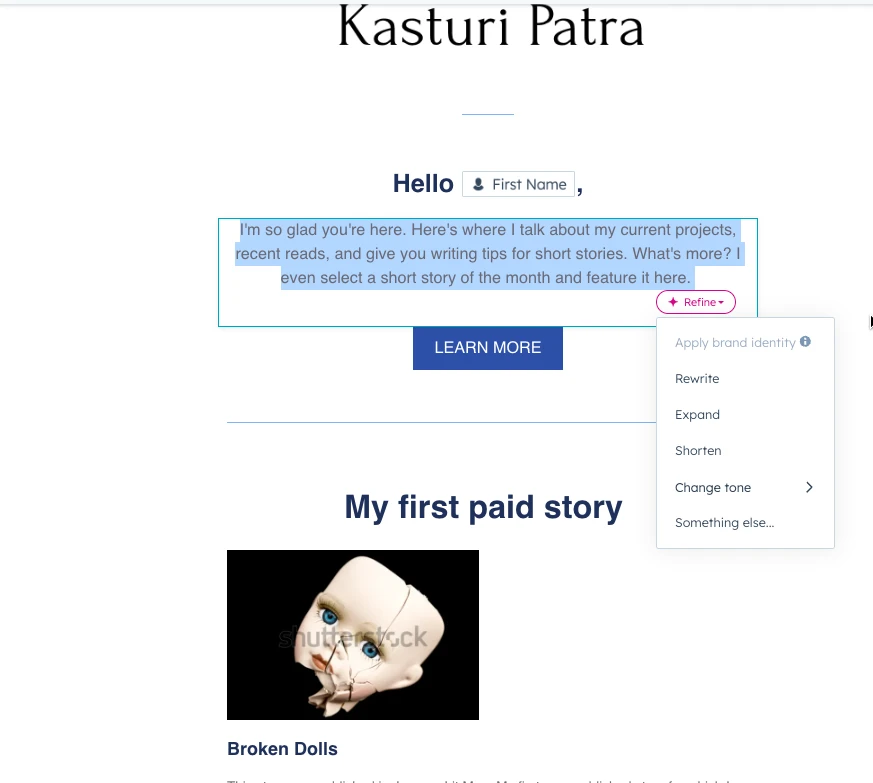
Forms and CTAs
For bringing in new leads, HubSpot's forms and calls-to-action (CTAs) truly stand out. The builders are user-friendly, much like the email editor, letting you design professional-looking lead capture tools easily.
You can format them to look good and on-brand. Importantly, you can also add boxes to seek user consent for data processing and communications, clearly stating your privacy policy. While you can include a direct payment link in forms, I found this specific feature requires a paid HubSpot subscription (tied to HubSpot Payments), adding to the overall cost.
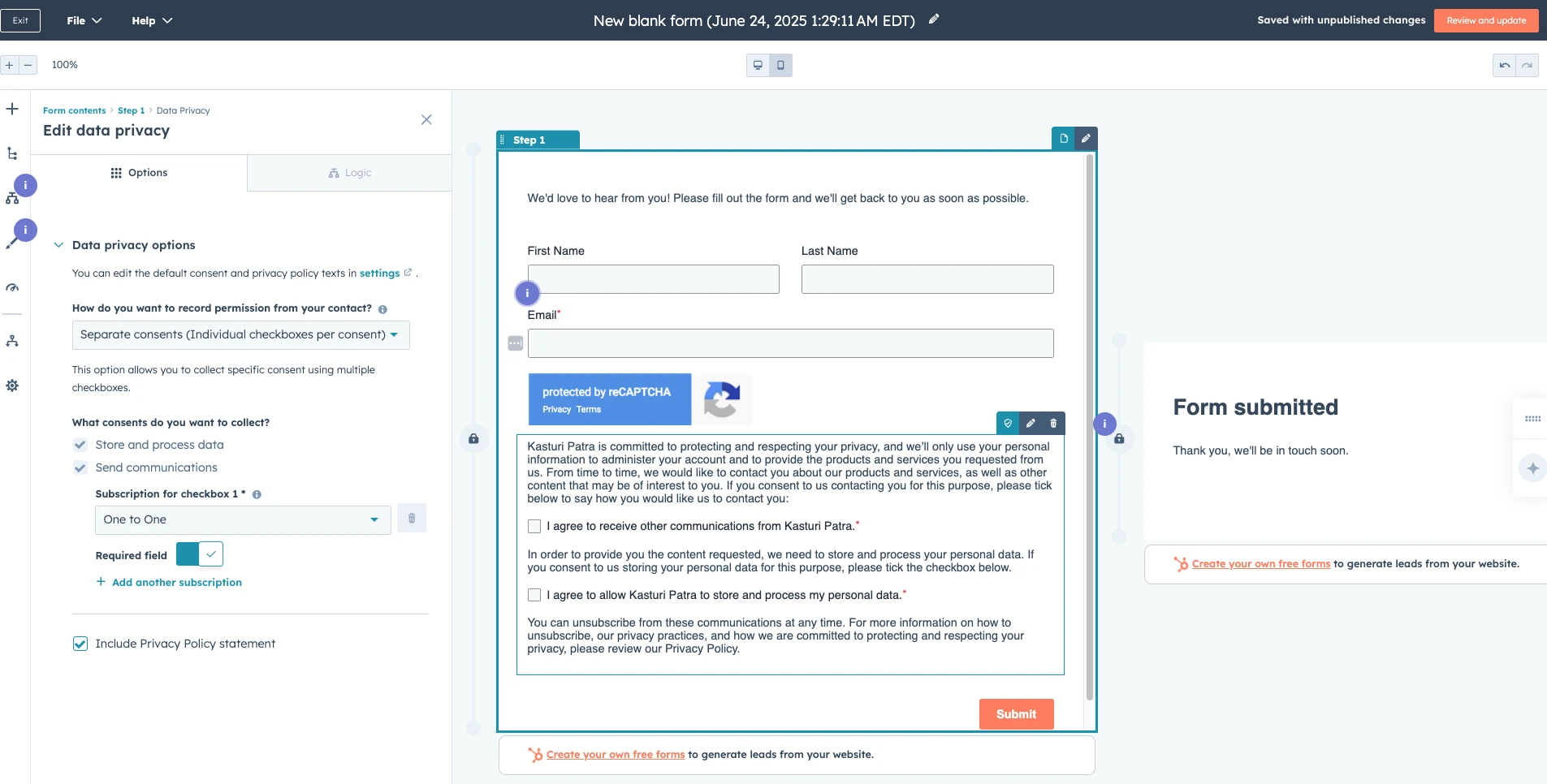
HubSpot also provides an impressive variety of CTAs, including pop-ups and embed templates you can place on your site. These are eye-catching and they help guide visitors effectively, with HubSpot tracking their views, clicks, and conversions straight into your CRM.
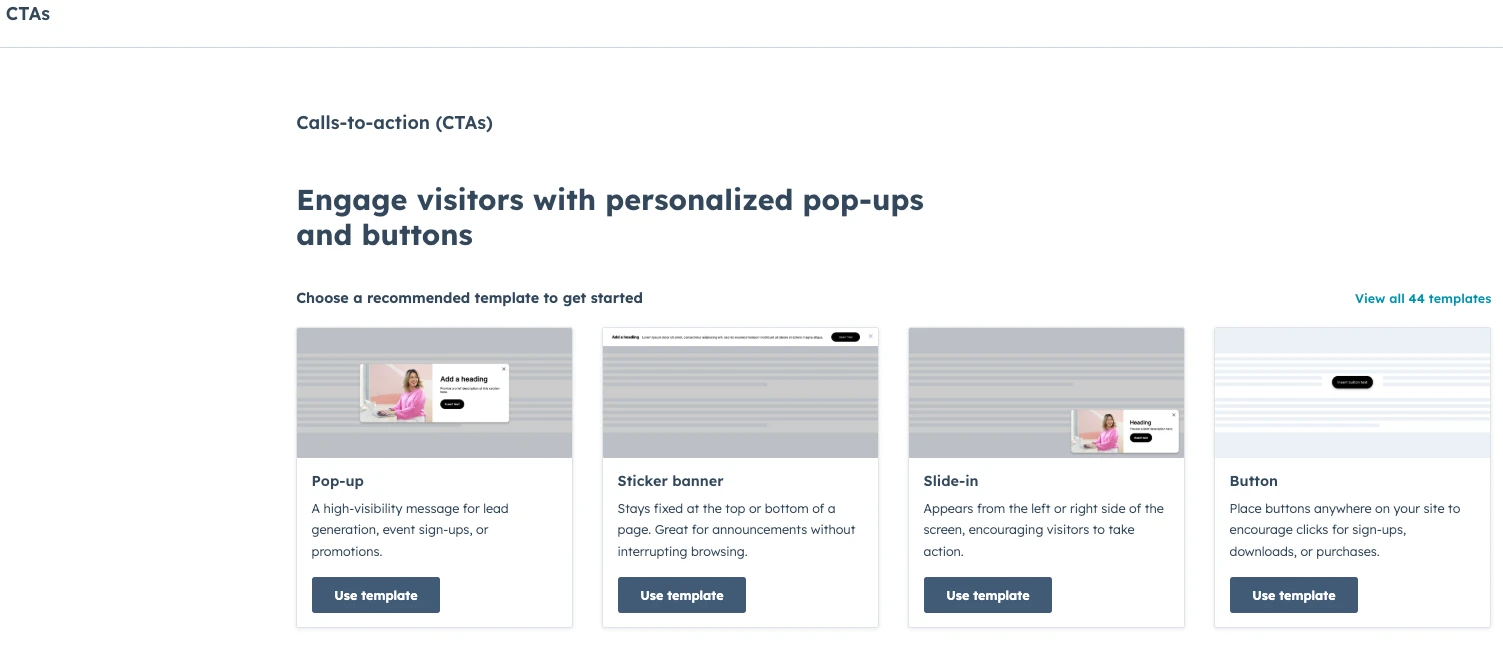
While the free plan includes basic marketing automations, like a simple thank you email after a form submission, the more complex workflows need an upgrade.
A/B testing capabilities
HubSpot offers A/B testing, a valuable way to optimize your emails. While exploring the email builder, I could clearly see the option to create two different versions of my email right there in the interface.
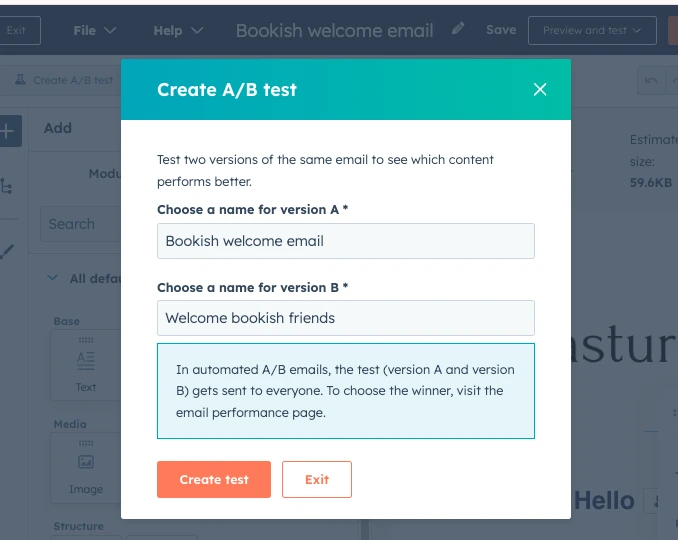
This allows you to test elements like subject lines or content variations. Here are two versions of the email I created:
Option A:
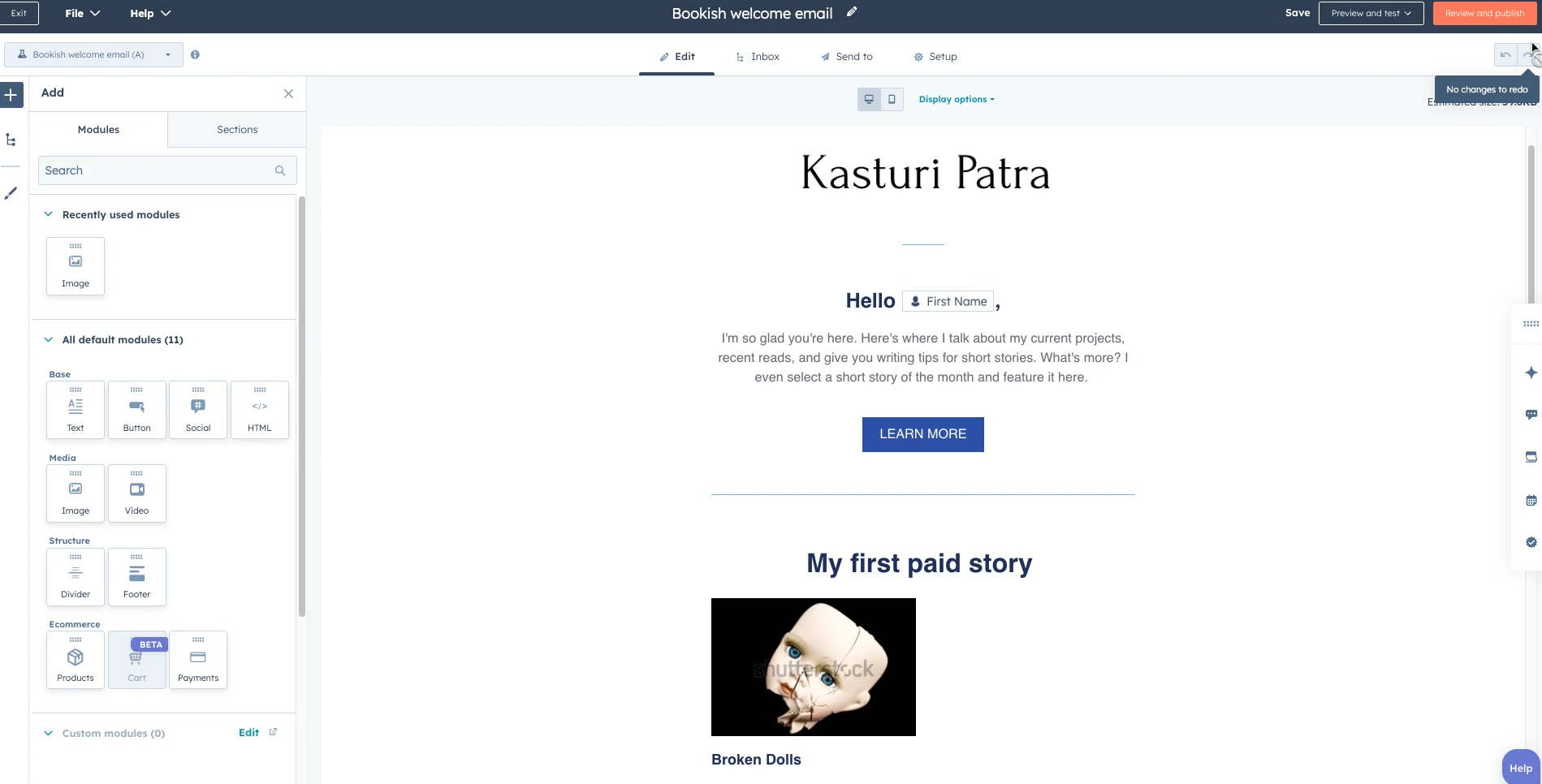
Option B:
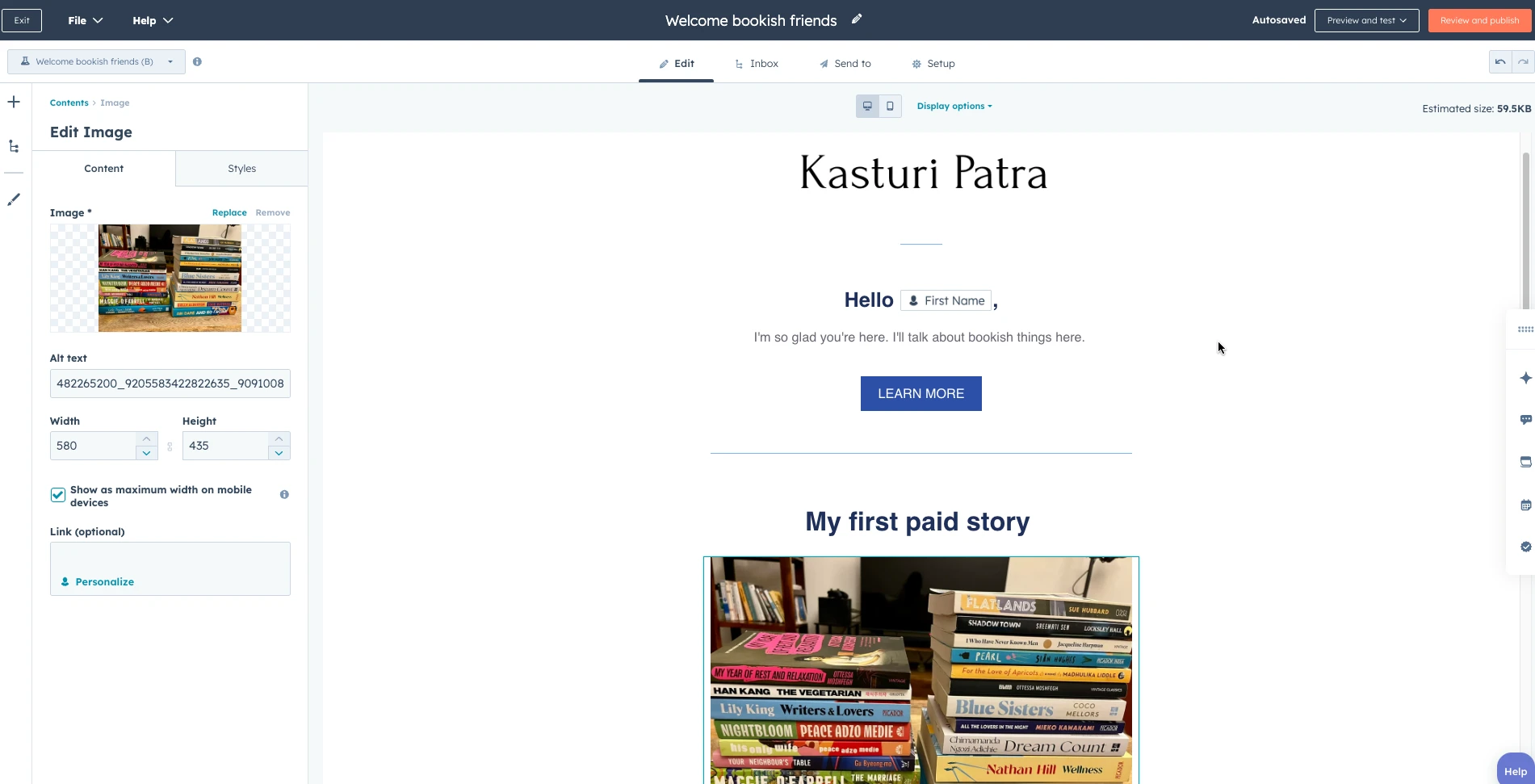
However, running a true A/B test, where the system sends these versions to a sample audience and automatically picks a winner based on performance, is a feature reserved for HubSpot's Professional and above tiers.
So, while you can prepare the versions, the sophisticated testing functionality isn't available for free or Starter tiers, limiting your ability to optimize campaigns.
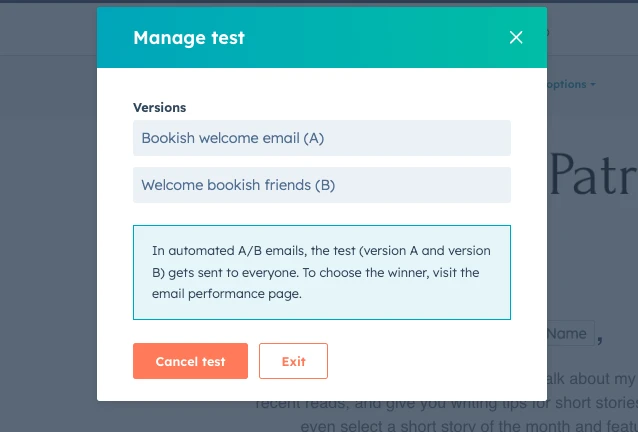
Automation workflows
HubSpot's automation workflows look visually powerful. You can map out sequences, like a welcome email when someone signs up, or a drip campaign using their pre-built templates. There are many templates available for automated campaigns, including common ones like welcome, loyalty program, and abandoned cart emails. The process involves defining steps and creating content right in the familiar email editor.
But the ability to fully automate forms and trigger these advanced email sequences beyond very basic, limited actions ultimately requires upgrading to the expensive Professional plan that starts at $890. So, while the visual builder is great, the depth of automation for free or Starter users is quite restricted.
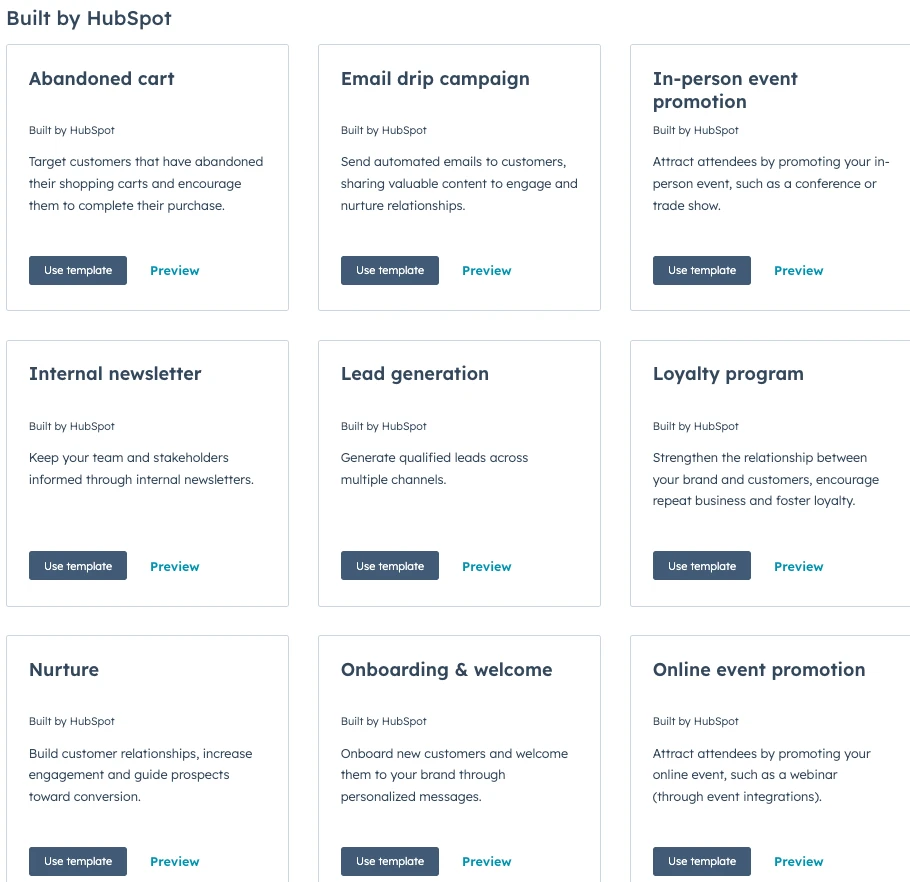
Advanced analytics and reporting
HubSpot offers a very detailed analytics dashboard.

The "Analyze" tab gives you a full view of your email marketing, showing stats like recipient engagement, delivery, and performance across different devices.
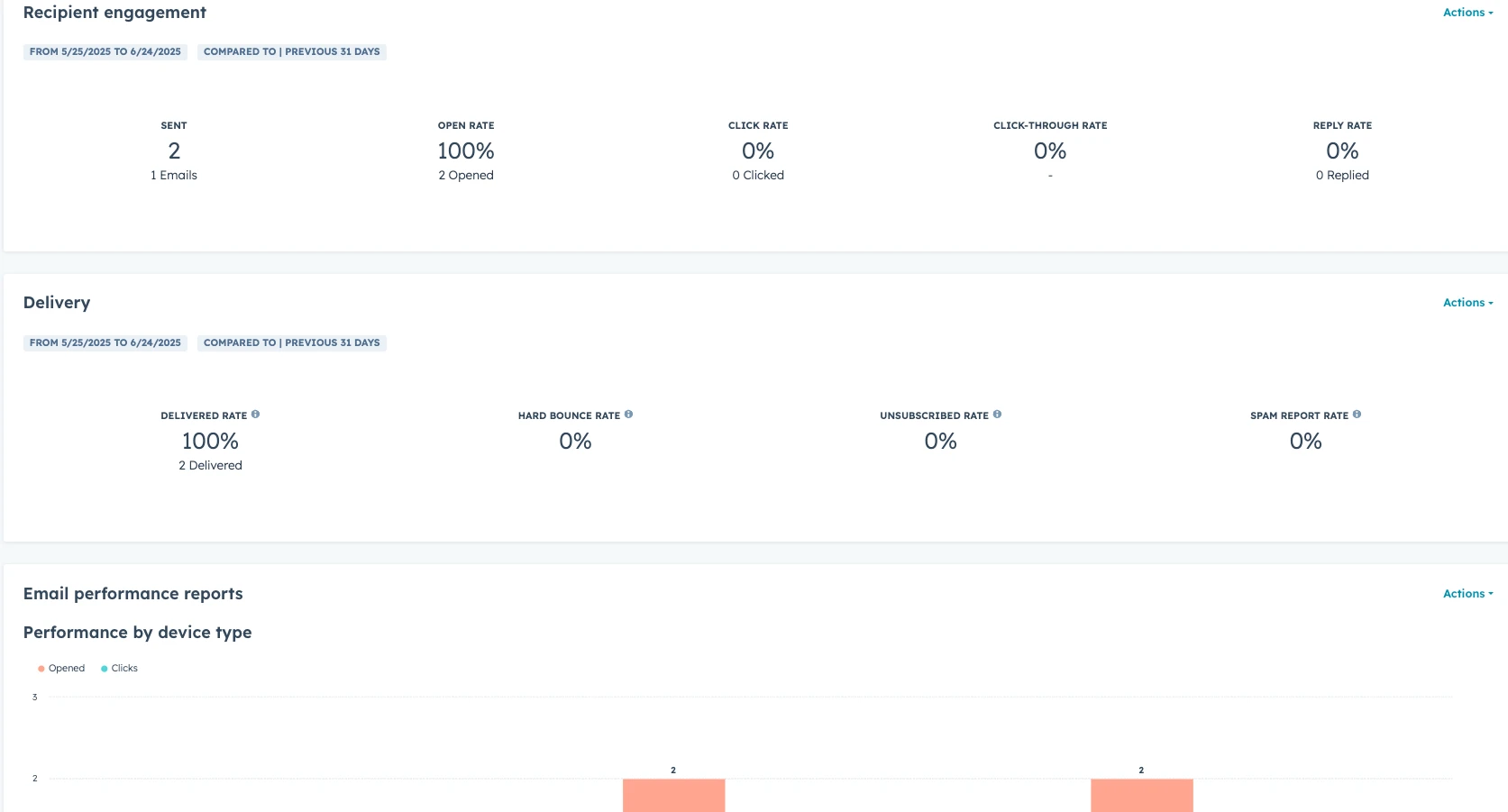
What I found really insightful was the "Health" tab. It shows areas for improvement, plus compares your email's performance against industry benchmarks, even recommending how to boost results.
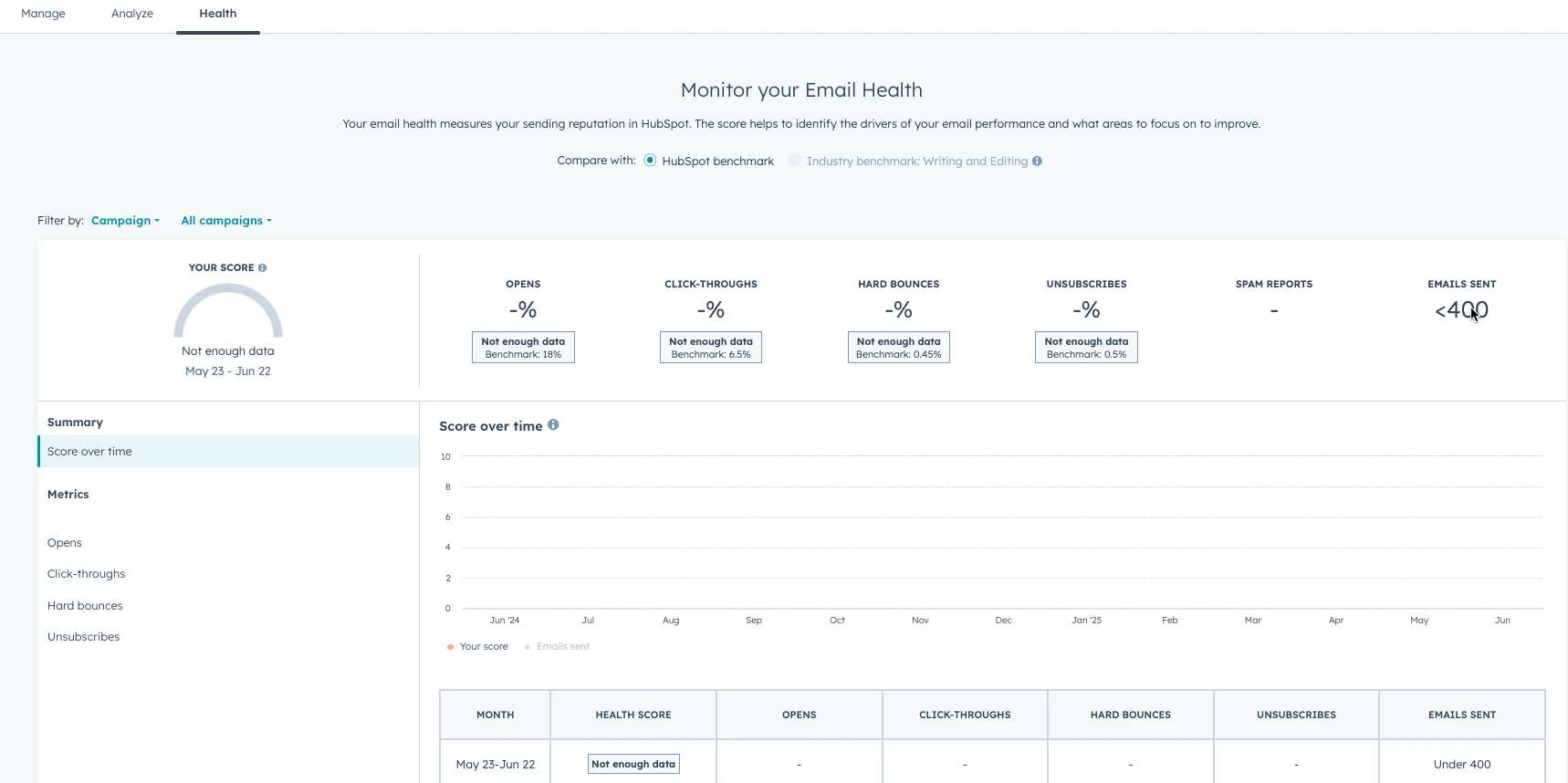
While incredibly powerful for data-driven marketers, this level of detail and the full range of reports can feel overwhelming for someone seeking a simpler interface. Much of this advanced reporting is also found in the Professional or higher tiers.
Transactional emails
Hubspot also offers a transaction email add-on for an extra price to send automated emails and system messages.

Integrations with CRM and third-party tools
The seamless integration with HubSpot's native CRM is, in my opinion, foundational to its email marketing power. Every email sent, opened, or clicked is logged directly on the contact's timeline in the CRM. This gives you a full, 360-degree view of every interaction with that person.
Beyond its own system, HubSpot also has a huge App Marketplace, boasting over 1,900 integrations. This wide reach means you can connect HubSpot to almost any other tool in your business, bringing all your data together and streamlining workflows. This is a big advantage, especially for larger operations.
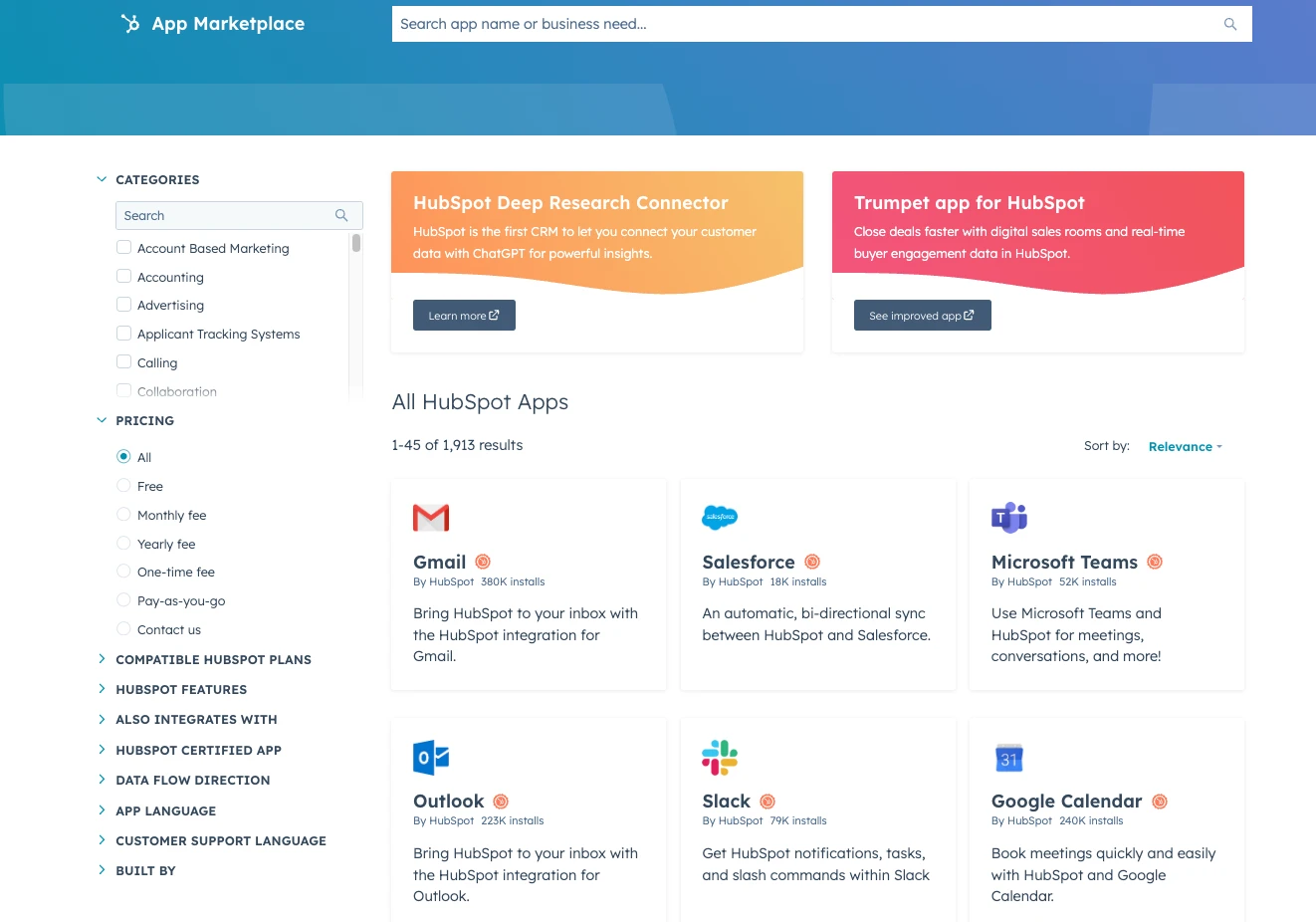
HubSpot email automation: How it works
Now, let's take a deeper look at HubSpot email automation builder and how one builds a workflow in that:
Email series (drip campaigns)
HubSpot's workflows are designed for creating email series, often called drip campaigns. I found their workflow templates for drip campaigns helpful for setup. When you begin, you name your campaign, set a goal, and pick your audience. Many templates are available for automated emails, including dedicated welcome, loyalty program, and abandoned cart emails.
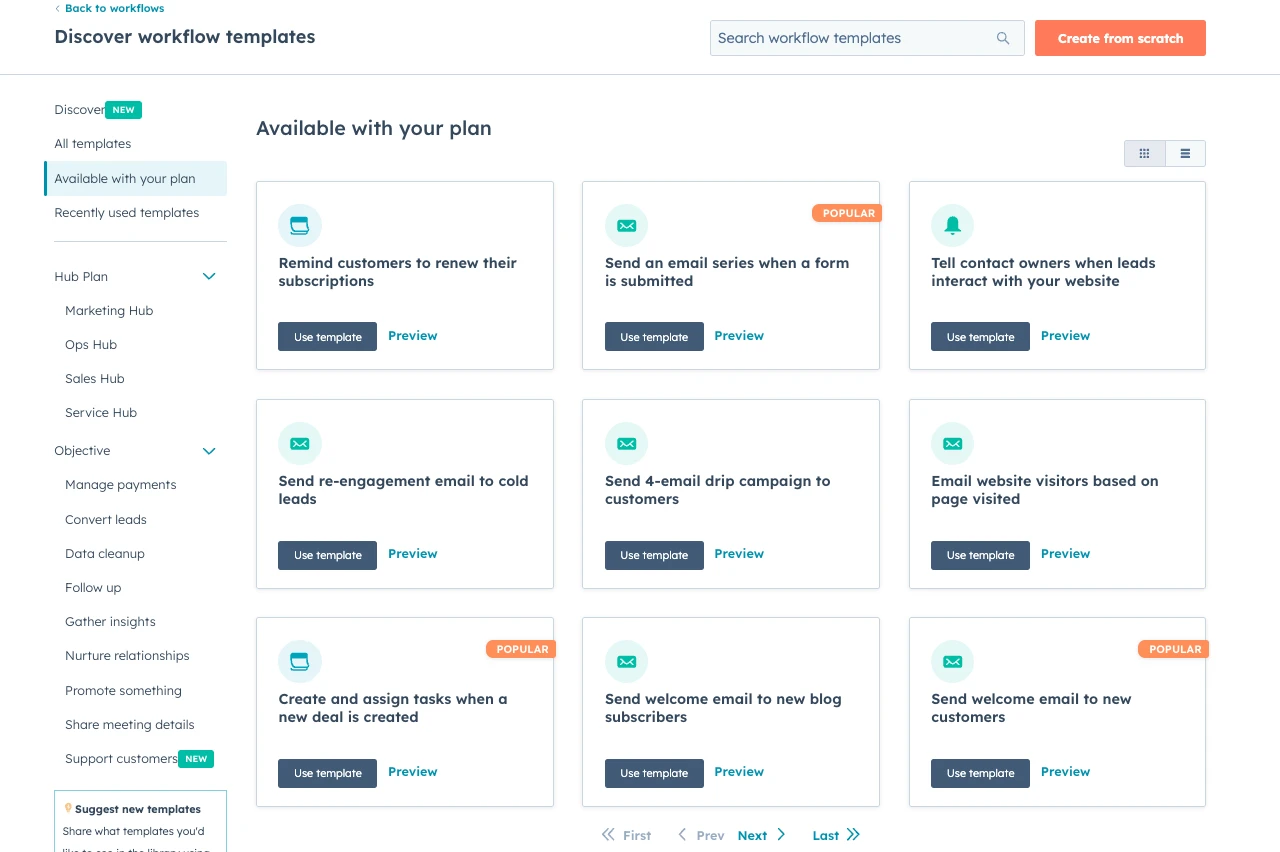
Once the workflow was created, I could define the steps needed to guide contacts through their journey. I could then craft emails right within the workflow using the familiar editor.
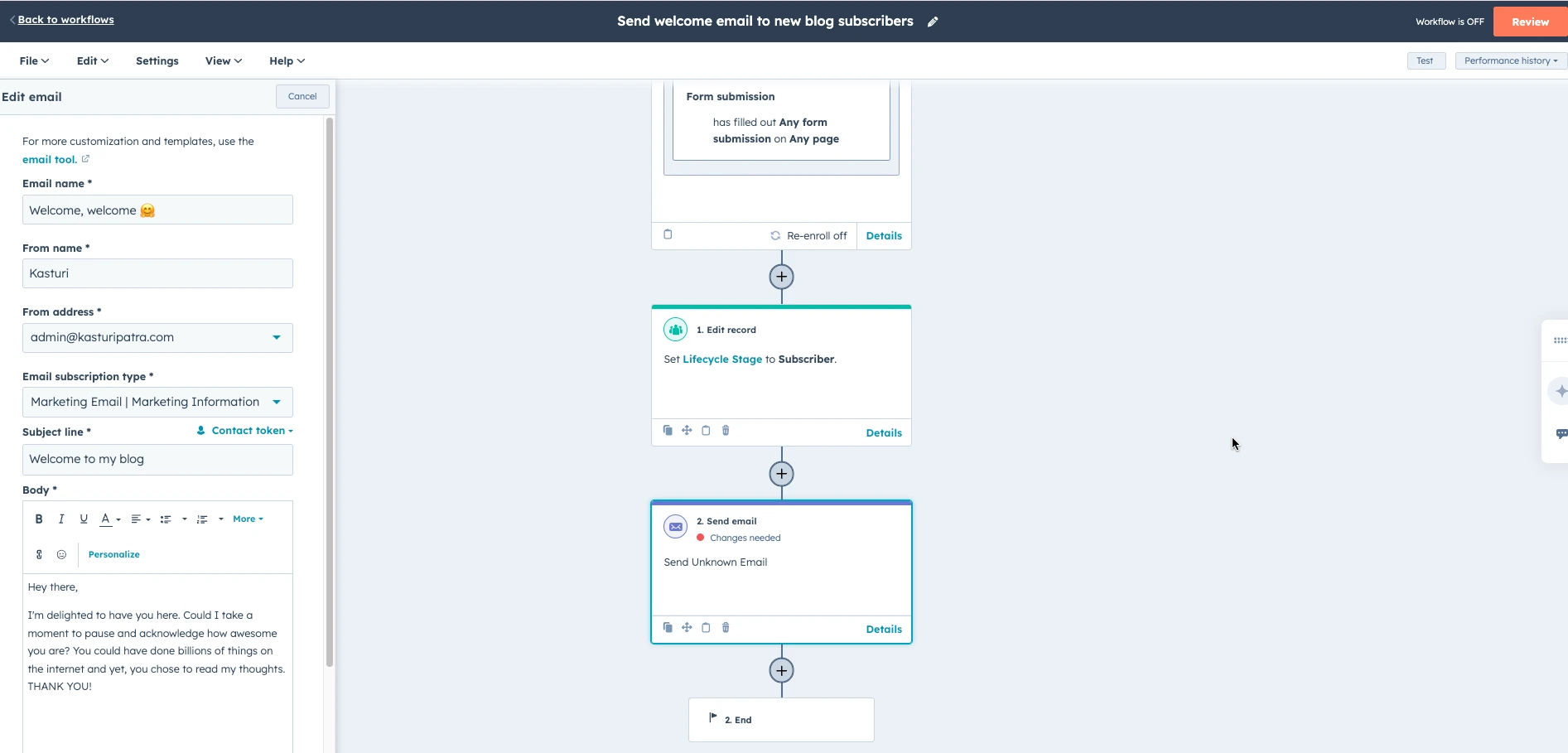
But we come back to the same issue. While the visual builder is great, accessing the full power of these automation features, like truly complex sequences beyond very basic, limited actions, usually requires a Professional plan. The depth of automation for free (1 workflow) or Starter tier (up to 10 workflows) is limited.
Behavioral triggers
Behavioral triggers let your emails or actions react directly to what a contact does. Imagine sending a specific follow-up if someone visits a certain page on your website or clicks a particular link in an email. HubSpot can connect these actions to automated responses.
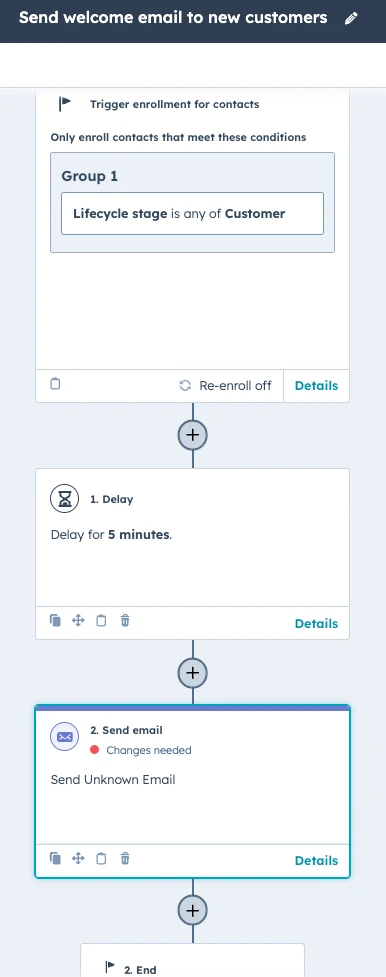
But once again (Are you tired of this refrain? I know I am!), setting up truly complex, multi-step behavioral automation usually needs a higher-tier Professional plan.
Using the visual workflow builder
The visual workflow builder is HubSpot's hub for all automation. In my experience, it's very intuitive. You pick what starts the workflow (an enrollment trigger), then drag and drop actions like 'Send email' or 'Delay' onto a canvas. The email editor within these workflow steps is the same easy-to-use tool found in forms and CTAs.
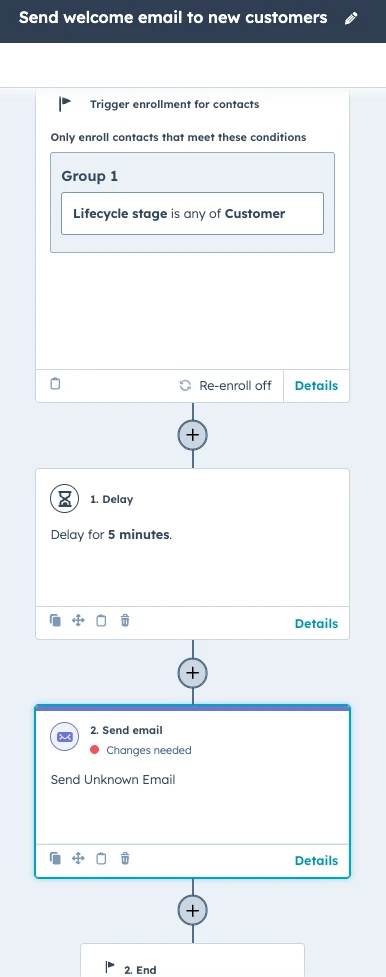
This visual approach makes even complex sequences easier to map out.
That said, the true power and scalability of this builder are often contingent on upgrading to the Professional plan, meaning the visual simplicity doesn't always translate to accessible advanced functionality for all users.
Pros and cons of using HubSpot for email marketing
Here’s a table showing the pros and cons of using HubSpot Email Marketing for your business:
| ✅ Pros | ❌ Cons |
|---|---|
| Deep CRM integration | High cost to enjoy the full suite of features including automation, advanced personalization, and A/B testing. |
| Powerful automation capabilities (at the pricier, higher tiers) | High in complexity and has a steep learning curve for the full platform |
| Comprehensive analytics | Email authentication is a paid feature meaning your email deliverability might suffer in the free plan |
| Robust lead capture (forms & CTAs) | Overkill for basic email needs |
| Great scalability for larger businesses | Significant price jump between tiers |
| All-in-one platform potential to consolidate marketing, sales, and services | Can be overwhelming to small businesses or solo entrepreneurs |
| Great personalization options using CRM data | Basic looking email editor with limited blocks to work with |
| Features like GDPR consent options and captcha to exclude bots | Limited support for lower tiers |
| A huge library of tutorials and learning content available, including the famous Hubspot Academy |
HubSpot pricing for email marketing
Understanding HubSpot's pricing helps you figure out its place in your business strategy. Email marketing features are part of their broader Marketing Hub, which comes in various tiers. Prices vary based on your plan, including marketing contacts and added seats.
Free plan: What’s included?
Basic email marketing: Send up to 2,000 emails per month to a limited number of marketing contacts (typically 100 contacts)
Email templates: Access to basic templates and a simple editor
Email reply tracking: Track when recipients reply to your emails
Email health reporting: Basic insights into deliverability and performance
No branding removal: HubSpot branding is present on emails
Limited automation: Basic email automation is available (e.g., a single automated email after a form submission); complex workflows are not included
No dedicated support: Only community support is available
Starter
Price: $15–$20/month (per core seat, often part of a bundled CRM Suite)
Contacts: 1,000 marketing contacts included
Features: Unlocks more email automation (up to 10 automated actions), personalization, landing pages, forms, and the ability to remove HubSpot branding from emails.
Note: Additional contacts and seats cost extra.
Professional
Price: Starts at $890/month (base price, billed annually for 2,000 contacts)
Contacts: 2,000 marketing contacts included
Features: Offers comprehensive email automation (unlimited workflows), A/B testing, dynamic content, advanced segmentation, and detailed analytics
Note: Requires annual commitment; $3,000 one-time onboarding fee; additional contacts and seats cost extra.
Enterprise
Price: Starts at around $3,600+/month (base price, billed annually for 10,000 contacts)
Contacts: 10,000 marketing contacts included
Features: All Professional features plus advanced reporting, custom objects, field-level permissions, multi-touch attribution
Note: Requires annual commitment; typically a $7,000 one-time onboarding fee; additional contacts and seats cost extra.
Is it worth the price?
In my view, HubSpot Email Marketing really fits mid to larger companies that need a full, all-in-one platform. It's perfect for businesses with complicated sales processes or those who want one clear view of every customer interaction across marketing, sales, and service teams.
HubSpot excels at letting you bundle their different hubs—Marketing, Sales, Service, CMS (Content), Operations, and even Commerce—all within one system. This creates a powerful, unified platform.
If you have a deep pocket and need advanced automation or detailed reporting, HubSpot offers that complete package.
Alternative to HubSpot for email marketing: Integration with MailerLite
While HubSpot's full Marketing Hub is powerful, for many businesses, a more user-friendly and highly effective email marketing solution might be a better fit. That's why a smarter strategy might be to pair MailerLite for emails and online presence with HubSpot's CRM. This marries robust features with practical affordability, giving you the best of both worlds.
Let’s check out some of the ways in which MailerLite stands out:
Intuitive and user-friendly drag-and-drop builder
Our drag-and-drop website builder is as intuitive as our email editor with over 90 content blocks, allowing anyone to create stunning, mobile-responsive sites quickly.
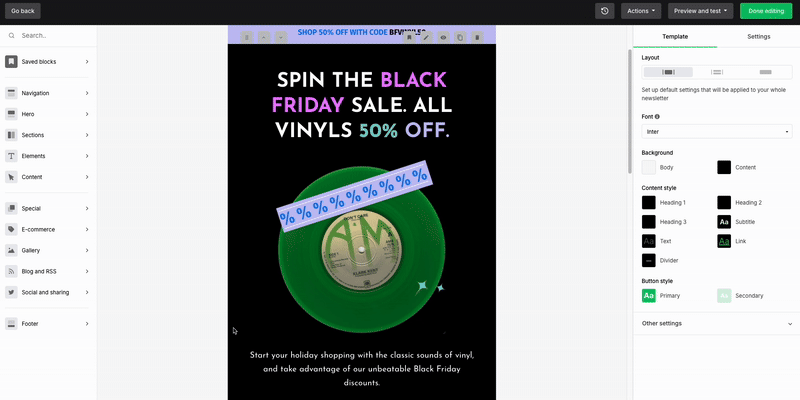
Powerful landing page builder
Our landing page builder is seamless and powerful. You can effortlessly create high-converting landing pages for your campaigns, complete with forms and pop-ups to capture leads. You can even generate landing pages with our powerful AI tools.
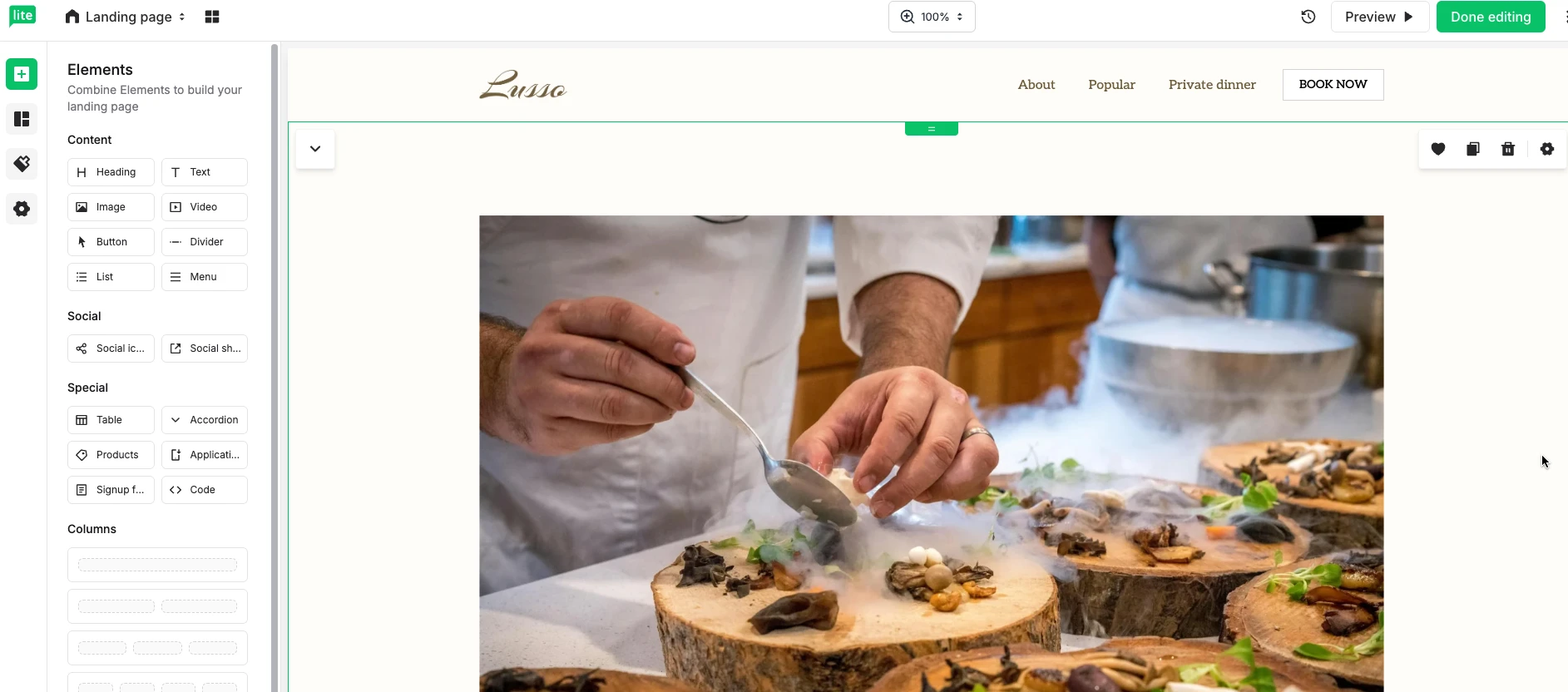
Option to sell digital products within the platform
Looking for an all-in-one platform that lets you monetize your content online? MailerLite lets you sell digital products directly from your websites and landing pages. This adds another layer of versatility, making it an all-in-one solution for those looking to monetize their content or services online.

Unlimited websites and landing pages
With MailerLite's paid plans, you don't just get email; you get the ability to create unlimited landing pages, websites and blogs. This is a game-changer for small businesses or entrepreneurs who want to establish a professional online presence without needing separate, expensive website builders or hosting solutions.
Additionally, since these tools use a similar drag and drop builder to our email editor, and have prebuilt templates and blocks, you can create the resources independently without needing to hire additional help
Generous free plan
Even its generous free plan includes an email automation builder and comparative reporting. What’s more, you can send up to 12,000 emails to 500 subscribers per month on the free plan.
Super-affordable paid plans
The paid plans are quite affordable, like the Growing Business plan (for 1,000 subscribers, unlimited emails) for $9/month (billed yearly). At this price, you get features like multivariate testing, dynamic emails, auto-resend, and unlimited websites, blogs, and landing pages.
MCP server and AI tools
Both HubSpot and MailerLite have MCP servers that let you connect data saved in the platforms to AI tools like ChatGPT and Claude.
However, while HubSpot’s MCP server has a complicated setup that requires a developer or someone willing to experiment with code, you can set up the MailerLite MCP server with any supported tool (including the entry-level paid plans of ChatGPT and Claude) in just a few clicks, without needing to use any code.
Once you’re set up, you can then perform actions in MailerLite or ask the tool to analyze your data and provide suggestions based on these exact metrics.
For example, you could ask the tool to:
Analyze previous subject lines and suggest ones that are likely to work in an upcoming campaign
Look at newsletter topics that have generated high engagement and suggest similar topics
Assess the performance of your most recent campaign or automation and provide a list of what went well and what could be improved
Identify subscribers based on specific criteria, such as campaign engagement
And you do all this using natural language prompts within your AI tool. Discover more about email marketing MCP use cases in this article.
As well as the MCP server, MailerLite has other AI tools that help you work smarter, such as email, image and landing page generation, and smart sending that analyzes the engagement of your subscribers to send email campaigns at the exact right time to each person.
All-in-one platform
MailerLite gives you an intuitive all-in-one platform to manage your website, landing pages, and email marketing while selling digital products.
While HubSpot is great for sales teams and large-scale, integrated operations, MailerLite is perfect for businesses looking to maintain their online presence cohesively and efficiently.
Plus, you can use a single account to connect with MailerCheck and MailerSend:
MailerCheck helps you optimize your subscriber list by verifying email addresses, improving deliverability.
MailerSend is a transactional messaging service for sending invoices, delivery updates, notifications and more straight from your app or website.
Here's a side-by-side comparison focusing on why someone might choose MailerLite over HubSpot Email Marketing:
| MailerLite | HubSpot | |
|---|---|---|
| Templates and editor | Huge library of 131 templates, intuitive drag-and-drop, over 90 content blocks | Provides around 37 templates and the email editor feels more traditional with considerably fewer pre-built content blocks |
| User-friendliness and ease of use | Intuitive, easy-to-navigate interfaces, and extremely user-friendly | Can be more complex with a steeper learning curve, especially for users focussed on email marketing |
| Affordability and cost-effectiveness | Offers a free plan for up to 500 subscribers and significantly lower priced paid plans | Much higher cost, especially for larger contact lists with advanced features typically locked behind higher-tier plans |
| Email deliverability | Consistently ranks among the best | Strong, but not as high as MailerLite |
| Customer support | Responsive and also available during free trial | Good, but MailerLite often preferred for speed and directness |
| Built-in tools (beyond email) | Includes built-in tools for creating landing pages, websites, signup forms, pop-ups and selling digital products all within the same platform | Offers landing page, form, and website builders as a part of its broader suite |
HubSpot, meanwhile, provides a powerful CRM to track customer interactions and help you with sales, inbound marketing, and customer support. The real magic happens when these two platforms work together.
The MailerLite integration with HubSpot, powered by Data Sync, hugely empowers your marketing. It automates data syncing and sharpens your email segmentation, without needing you to write a single line of code.
So, who thrives with this approach?
Small to mid-sized e-commerce businesses: Centralize customer data in HubSpot CRM. Sync rich profiles (e.g., purchase history) to MailerLite for targeted promotions.
Agencies and freelancers: Manage diverse client campaigns efficiently with MailerLite's cost-effective sending. Use HubSpot CRM to track client interactions and campaign performance.
Coaches and consultants: Organize client relationships and personalize communication.Track leads and sales in HubSpot CRM. Send targeted newsletters via MailerLite, informed by detailed CRM notes.
What about the cost?
You might wonder why two subscriptions are cheaper. It's simple: you avoid HubSpot's pricier Marketing Hub tiers.
HubSpot's Marketing Hub Professional, which offers full email automation and advanced features, starts around $890 per month (billed annually for 2,000 contacts).
Compare that to the hybrid:
MailerLite's Growing Business plan (1,000 subscribers) is about $9/month. Add HubSpot's free CRM, and your total is just $9/month.
Even MailerLite's Advanced plan (for 1,000 subscribers, about $18/month billed yearly) combined with HubSpot's Starter CRM (around $15/month per seat) is still only $33/month (for one seat).
This hybrid model gives you top-tier email features and strong CRM functionality at a dramatically lower cost. You pay for exactly what you need, avoiding the hefty price tag of an all-encompassing platform.
HubSpot Email Marketing FAQs
Is HubSpot Email Marketing free?
Yes, HubSpot offers a free version of its Marketing Hub with basic email marketing tools. However, as I found, full email domain authentication (crucial for professional appearance and deliverability) requires a paid plan.
How many emails can I send with the free plan?
You can send up to 2,000 marketing emails per month with HubSpot branding on the free plan.
Can I send newsletters with HubSpot?
HubSpot's email marketing tools are perfectly capable of sending newsletters. They offer various templates and an easy-to-use drag-and-drop editor for this purpose.
What are some cheaper alternatives?
If HubSpot's pricing is too high for your email marketing needs, consider platforms like MailerLite, which offers a whole suite of email marketing features starting at just $9 a month when billed yearly.
Does HubSpot offer discount pricing for startups and nonprofits?
Yes, HubSpot offers a 40% discount for nonprofits. It's always best to check directly with HubSpot for current offers and eligibility.
Can HubSpot send bulk emails?
Yes, HubSpot is designed for sending bulk marketing emails. It enforces strict requirements to ensure high deliverability and maintain sender reputation, requiring verifiable opt-in consent for all contacts.
Final verdict: Is HubSpot Email Marketing right for you?
If your business needs an all-in-one, deeply integrated powerhouse for sales, marketing, and service, and you have the budget, HubSpot's full Marketing Hub is certainly a strong contender. It's built to scale with complex needs.
But for many, that comprehensive suite is simply overkill. If you're a small to mid-sized business, a solo entrepreneur, or you primarily need effective, straightforward, and affordable email marketing, HubSpot's paid tiers quickly become expensive.
My strong recommendation for these situations is to opt for a hybrid approach. Use a dedicated tool like MailerLite for your email campaigns. It's user-friendly, is a top performer in terms of deliverability, and offers robust features at a fraction of the cost.
Then, complement MailerLite with HubSpot's powerful CRM. This pairing gives you superb email capabilities and a central hub for all your customer data. It’s a smarter way to grow, balancing specific needs with practical costs.
